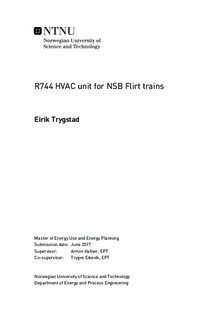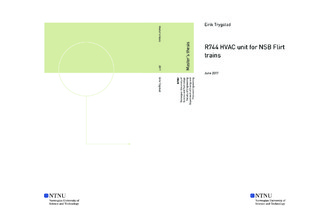| dc.description.abstract | The vast majority of current air conditioning systems, for railway HVAC applications, utilize high global warming potential (GWP) hydrofluorocarbon (HFC) refrigerants in a vapor compression cycle. In Europe, the dominating refrigerants are R134a and R407C, constituting 75 and 25% of the total stock, respectively.
Fluorinated greenhouse gases (GHG), such as HFCs, accounts for 2.5% of the overall GHG emissions, expressed in GWP (EU 2013), and are as a consequence being regulated at an increasing rate, through the revised F-Gas regulation of 2014, (EU) No 517/2014, that aims to reduce EU fluorinated GHG emissions by two thirds of the 2010 levels by 2030.
Because of the legislations and incentives put into place, both at the national and international level, the demand for environmentally benign HVAC&R technology, with viability in terms of achieved system efficiency and cost, is high, and can be expected to increase in a range of sectors the forthcoming years.
A review of current railway HVAC technology, gives strong indication that R744 (CO2) vapor compression units are one of the most viable candidates for the future, able to meet virtually all requirements with regard to environmental impact, safety, reliability and energy efficiency.
A newly developed, energy efficient and environmentally friendly prototype R744 HVAC unit, will be tested onboard a commuter trainset, operated in the Oslo area, during a test campaign to be initiated late 2017. The goal of the test campaign is to evaluate the viability of the prototype in terms of being a replacement for the current standard R134a HVAC units, outfitted on the Norwegian railway operator NSB s railway fleet.
The prototype have the ability to operate in reversed mode, thus enabling delivery of heat to the passenger compartment through the ventilation air, down to an ambient temperature of -20℃. Moreover, the prototype utilize suction line heat exchangers, and offers ejector-supported fluid expansion during AC-mode operation, in order to minimize losses related to fluid expansion.
Results from laboratory bench tests of the prototype, presented in this thesis, indicate that performance requirements can be met, provided an attentive approach, with regard to system design and control strategy, is applied.
At the current stage of development, the prototype achieves a total cooling capacity of 18.6 kW, at the design summer conditions, specified in the European Standard for air conditioning of main line rolling-stock EN 13129 | |

